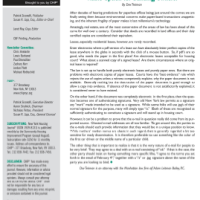Contents
By Dov Treiman
After decades of hearing predictions for paperless offices being just around the corner, we are finally seeing them because the environmental concerns make paper-based transactions unappetizing, and the inherent fragility of paper makes it last millennium’s technology.
Amazingly, real estate, one of the most conservative of the areas of law has been ahead of this curve for well over a century. Consider that deeds are recorded in land offices and their duly certified copies are considered their equivalent.
Leases, especially residential leases, however, are rarely recorded.
Enter electronics where a pdf version of a lease can have absolutely letter perfect copies of the lease anywhere in the globe in seconds with the click of a mouse button. So, if pdf’s are so good, who needs the paper in the first place? Are electronic leases acceptable for housing court? What about a scanned copy of a signed lease? Are there circumstances where an original lease is required?
The law is set up to handle both purely electronic leases and purely paper ones. But there are problems with electronic copies of paper leases. Courts have the “best evidence” rule which rejects the use of copies unless a witness competently explains why the paper document is not available. Generally nothing but the destruction of the paper document is good enough to allow a copy into evidence. If absence of the paper document is not satisfactorily explained, it is considered never to have existed.
On the other hand, if the document was completely electronic in the first place, then the question becomes one of the authenticating signatures. Very old New York law permits as a signature any “mark” made intended to be used as a signature. While some folks will use jpg’s of their normal signature for the purpose, many will simply type “/s.” Both of these are recognized as sufficiently authenticating to constitute a signature and will stand up in housing court.
However, it can be a problem to prove that the e-mail in question really did come from its purported source. Ghosted e-mail addresses are all too familiar. To get around this, the parties to the e-mails should each provide information that they would be in a unique position to know. While mothers’ maiden names are classic in such regard, that is generally regarded a bit too sensitive for ready dissemination. It is therefore preferable to use something like the color of the first card driven or the middle name of a particular child.
The other thing that is important to realize is that it is the very nature of e-mail for people to be very brief. They may agree to a deal with an e-mail consisting of “ok”. If that is the case, the other party should insist on having something more specific like, “I agree to the terms you set forth in the email of February 4th,” together with a “/s” or .jpg signature above the name of the party you are looking to bind.


 Twitter
Twitter